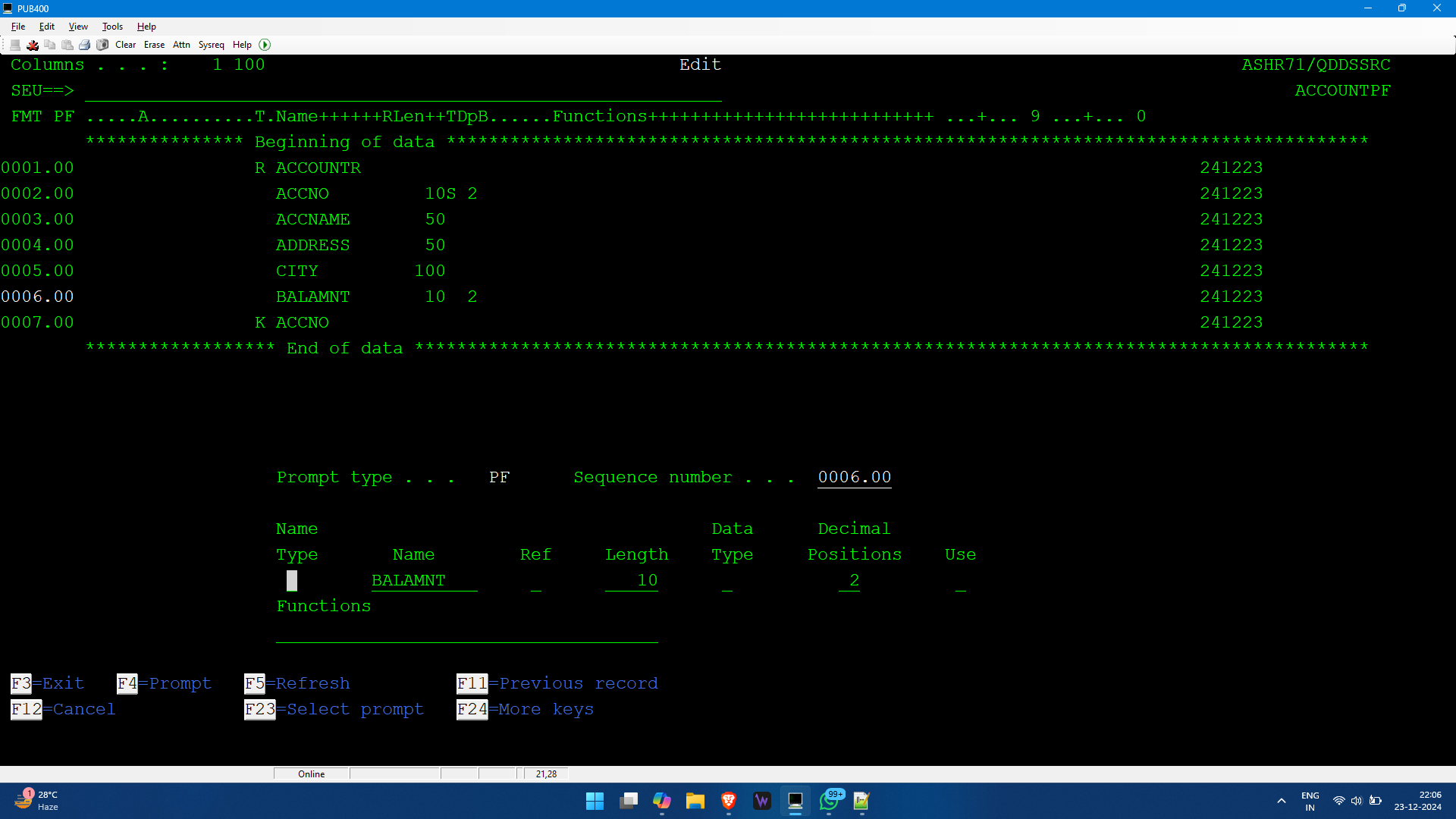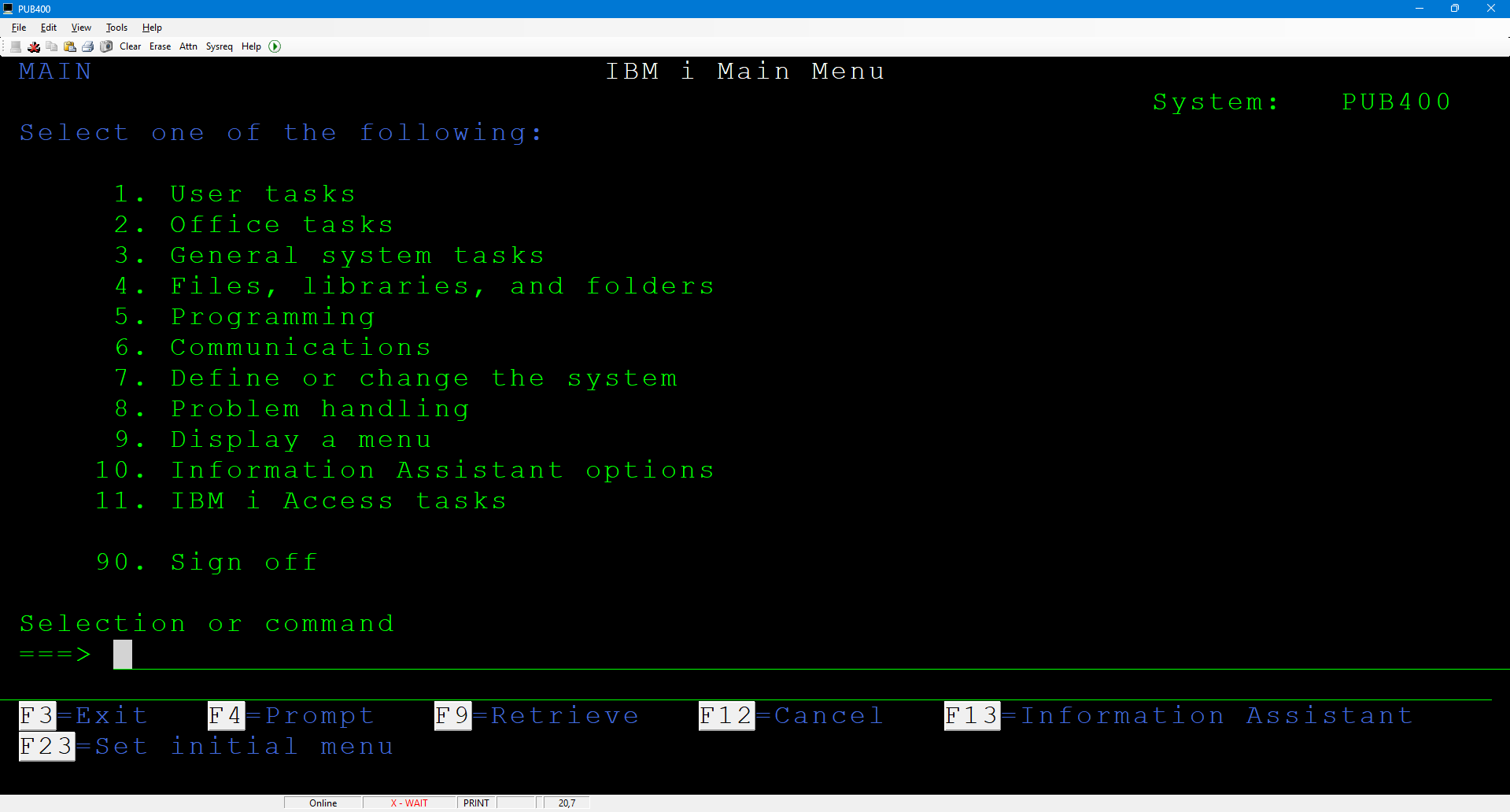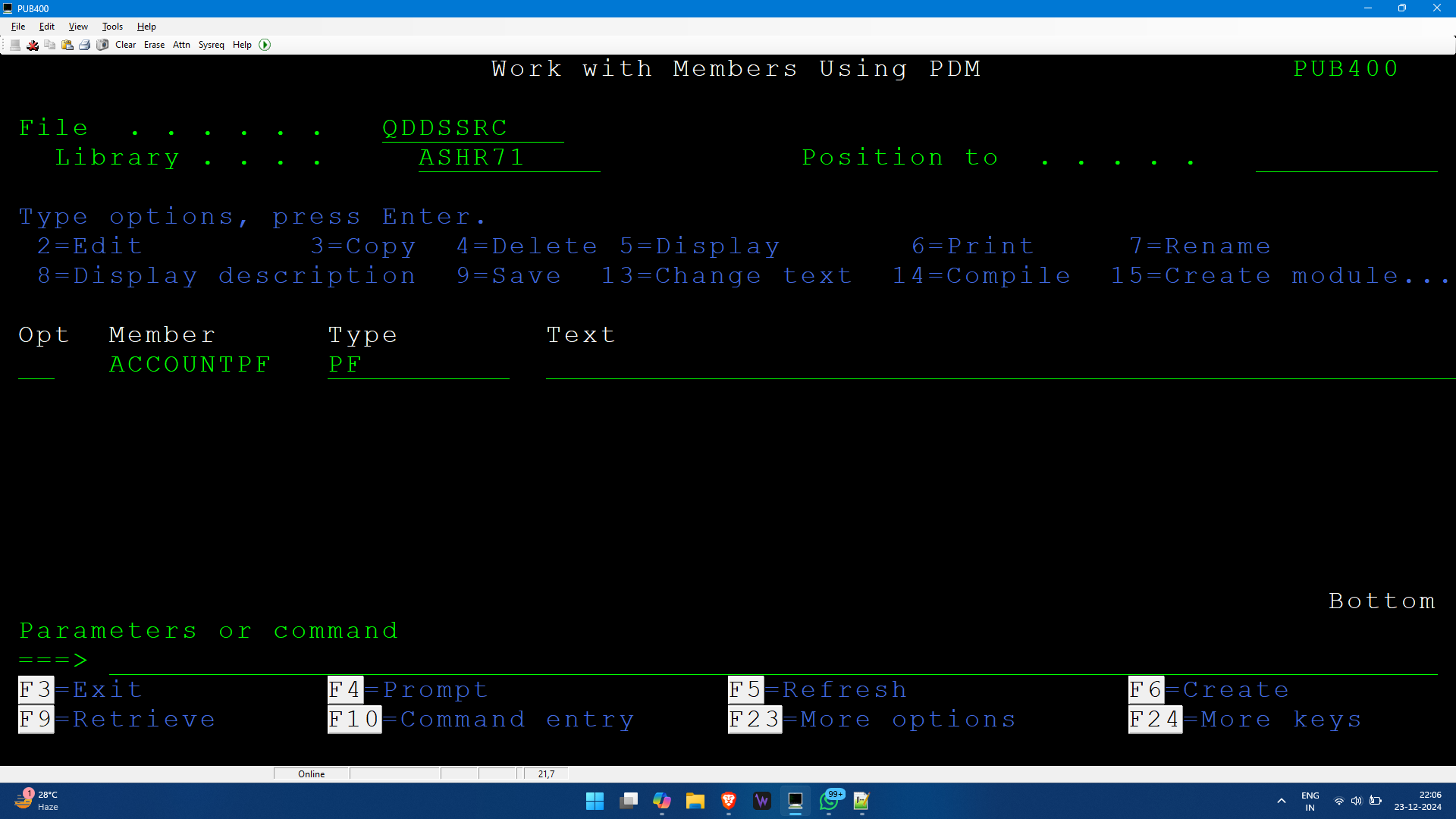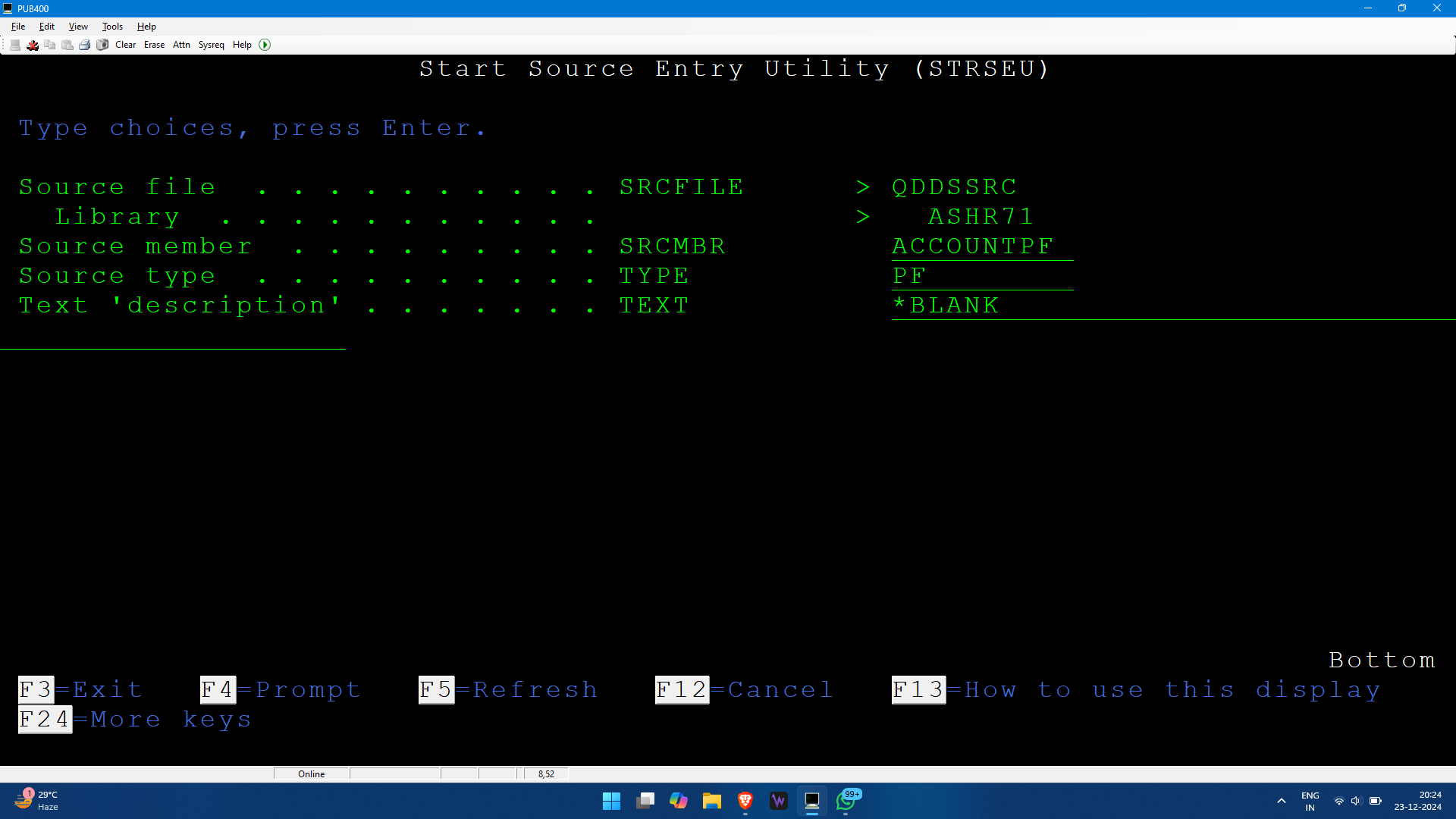Welcome to my notes for AS400. I am making these notes based on the lecture I am attending, from my research, and my own knowledge.
There could be mistakes; you are free to correct me. Thank you!
Have a look below for better understanding and view.
= RPGLE Programs
- Readme.md (Notes main)
- Cheatsheet for Commands
-
IBM i: A machine designed to replace mainframes at a lower cost.
-
OS: OS400
-
Database: DB2
-
Software used ot access OS400: Mochasoft
-
References:
-
IBM® Rational® Developer for i (RDi): Provides an integrated development environment (IDE) to create, maintain, and modernize applications on the IBM i platform.
- Create a source member.
- Compile that member to create an AS400 object.
If there is a file of RPGLE, it will be kept in qrpgsrc or qrpglsrc, like that CLP in qclsrc, SQL in qsqlsrc, DDS in qddssrc.
-
CREATE: Starts with
CRT -
DELETE: Starts with
DLT -
WORK: Starts with
WRK -
DISPLAY: Starts with
DSP -
COPY: Starts with
CPY -
Library:
LIB -
Source:
SRC -
To create a library:
CRTLIB -
To create a source physical file:
CRTSRCPF
QDDSSRCfor DDS fileQRPGLSRCQCLSRCfor CL Source
QTEMP: Temporary buffer library
-
DDS Way:
- Two types of files:
- Physical Files: Contains actual data.
- Logical Files: Views on physical file data (like views/indexes in SQL), can be built on one or multiple physical files.
- Commands:
- (Key) ACCOUNTNO: Numeric, Max Length: 10
- ACCOUNTNAME: Char, Length: 50
- ADDRESS: Char, Length: 100
- ACNTBAL: Numeric, Length: 10, Decimal Positions: 2
-
File Level Entries:
- Not mandatory; contains only functions/keywords.
-
Record Level Entries:
- Contains type, name, and functions.
- Type
Rfor record level entry. - Click F4, Type:
R, Name:ACCOUNTR
 To add a new line, use
To add a new line, use Iin the left part as shown above. To add multiple lines, add the number of lines along withIlikeI2for add 2 lines. If you want to add the lines in between any field or record, keep the pointer above on left where you want to add and typeIand enter. -
Field Level Entries:
- Contains field names, data types, keywords.
- Click F4, Name:
ACCNTNO, Length: 10, Position: 0 - Click F4, Name:
ACNTNAME, Length: 50 - Repeat for
ADDRESSandCITY - Click F4, Name:
BALAMNT, Length: 10, Decimal Positions: 2 (ensure no blank space in length)
-
Key Level:
- To add the key.
- Click F4, Type:
K, Name:ACCNTNO - Save and continue by typing
SAVEin SEU line.
 This contains the physical file entry data. Beware of spaces.
This contains the physical file entry data. Beware of spaces.
- Go back to PDM, add Option 14 to compile.
- Check
WRKOBJto see the object files.
- Command:
UPDDTA ACCOUNTPF- To change according to some account number, enter the number in the account number field and click F5 in format.
- New Entry: F10
- Command:
RUNQRY *N ACCOUNTPF
- Two types of files:
-
SQL/DDL:
- To start SQL, use
STRSQLand press ENTER; SQL SESSION will appear, and add your SQL queries. If you don't know the syntax, use F4 to prompt and make the query. - Retrieve (F9): Can be used to get the used line again. Keep the cursor on the query to be repeated and click F9; that query will appear.
- To start SQL, use
- For the primary key in DDS, it should be explicitly mentioned to make it unique; otherwise, it won't be unique just by being the key.
- Go to PDM, use EDIT (Option 2), before the file level, make a line, and in functions add
UNIQUE. Then Compile.
- Go to PDM, use EDIT (Option 2), before the file level, make a line, and in functions add
- After compiling, a new object is created, and the data will be erased. To avoid this, back up the data.
- Need for Logical File:
-
Example: If there is a table with
EMPNOandEMPCITY, whereEMPNOis the key. If you want to get employee data according to the city and makeEMPCITYthe key, it will affect other programs if you just change the key. Instead, create a logical view and makeEMPCITYthe key and work on it. -
Commands:
- Go to PDM, click F6, Create a source adding LF type and all (name:
ACCOUNTLF), Get into Edit => Prompt type = R, Record Name =ACCOUNTR(exactly the same as the physical filename), in functions add "PFILE(ACCOUNTPF)" (to know which is the physical file). - Next line: add Type K, Name:
CITY(no need for file level entry since we need all fields). - Compile it, then run:
RUNQRY *N ACCOUNTLF - If you update the logical file, it will update the physical file too. i.e., Logical file creates an access path to the physical file.
- Go to PDM, click F6, Create a source adding LF type and all (name:
-
CRTLIBWRKMBRPDMUPDDTAWRKOBJRUNQRY *NSTRSQLCRTSRCPF
-
Create a library:
CRTLIB ashlib- To check if the library exists:
WRKOBJ ashlib -
Create a source physical file:
CRTSRCPF FILE(ashlib/qddssrc) -
Work with members in the source physical file:
WRKMBRPDM FILE(ashlib/qddssrc) -
Create a member.
Note: Numbers need to be left-justified. To do this, click insert and then space. To use F keys higher than 12, use shift + the incremented value (e.g., for F14, click shift + 2; for F20, click shift + 8).
- File level
- Record level -
R - Field level - needs
PFILE() - Key level -
K - Select/Omit level -
SorO
-
Logical file error due to library default: Use the
CHGCURLIBcommand to set your library as the current library, then compile.CHGCURLIB LIB(ashlib) -
Debugging Errors:
- Check all spool files created by an interactive job:
WRKSPLF- Select assistance level or F21, and change it to 2 intermediate.
- Give 5 in opt to display and then give B in control to get to the bottom of the file as the error will be present at the end of the file.
-
Delete spool file:
DLTSPLF *SELECT
-
Display file field description:
DSPFFD -
Display file description:
DSPFD -
Display all files starting with
emplfobjects:WRKOBJ emplf* -
Display all dependent files (especially logical file objects):
DSPDBR FILE(ashlib/<FILE>) -
Delete objects (object type will be *FILE):
DLTOBJ OBJ(ashlib/<FILE>) OBJTYPE(*FILE)
-
Operators:
- COMP EQ/GT
- CMP
- VALUES
- LIST
Give this when using S/O type to compare and select the fields in the function field. For example:
CMP(EQ 'HYD')With dynamic select, it happens at run time. It happens after the system runs and identifies all.
- To allow lowercase values, go to edit change source settings "Change session defaults" or F13. Then change uppercase input only to
N.
- For joins, if you need to take a common field into the output, use
JREF()and mention from which file to show. For example,JREF(1)if you need to refer to the first file.
- A: Character
- P: Packed Decimal (default: 2 digits occupy 1 byte) 5 or 6 bytes
- S: Zoned Decimal (1 digit occupies 1 byte) 10 bytes
- L: Date
- T: Time
- Z: Timestamp
- File Level:
UNIQUE,FIFO,LIFO,FCFO,DYNSLT,JDFVAL - Record Level:
PFILE,JFILE,TEXT - Field Level:
JREF(Join if),COLHDG(Column heading),VALUES/CMP - Key Level:
ABSVAL(Absolute value),ALIAS,DESCEND
- Can be done using
STRSQL, but it's preferable to create files inQSQLSRCfor future alterations.- Create source file
QSQLSRC. - Create a source member for SQL type.
- Create source file
Note: SQL cannot be compiled using option 14 here. To execute SQL, use the command RUNSQLSTM, go for prompt F4 give commitment control as none.
-
NOT NULL WITH DEFAULT is added because when inserting data only to specific columns and others are left empty, SQL will assign default values like 0 for int, space for text instead of NULL, which causes problems with RPG programming.
-
Updating the Table: You have to delete the table if you want to update the table structure. Create table can only be done once.
DROP TABLE <TABLE>
ASSIGNMENT - CREATE STUDENT TABLE AND MARKS TABLE, ENTER DATA.... ROLLNO, TOTAL MARKS, MARKS OBTAINED, PERCENTAGE... CREATE A VIEW.
Student table:
Columns . . . : 1 80 Browse ASHLIB/QSQLSRC
SEU==> STDNTTABLE
FMT ** ...+... 1 ...+... 2 ...+... 3 ...+... 4 ...+... 5 ...+... 6 ...+... 7 ...+... 8
*************** Beginning of data ***************************************************************************************
0001.00 CREATE OR REPLACE TABLE STDNTTABLE ( 241226
0002.00 ROLLNO INTEGER NOT NULL WITH DEFAULT, 241226
0003.00 NAME VARCHAR(20) NOT NULL WITH DEFAULT, 241226
0004.00 ADDRESS VARCHAR(20) NOT NULL WITH DEFAULT, 241226
0005.00 PRIMARY KEY (ROLLNO) 241226
0006.00 ); 241226
****************** End of data ******************************************************************************************
MARKS TABL:
Columns . . . : 1 80 Browse ASHLIB/QSQLSRC
SEU==> MARKSTABLE
FMT ** ...+... 1 ...+... 2 ...+... 3 ...+... 4 ...+... 5 ...+... 6 ...+... 7 ...+... 8
*************** Beginning of data ***************************************************************************************
0001.00 CREATE OR REPLACE TABLE MARKSTABLE ( 241226
0002.00 ROLLNO INTEGER NOT NULL WITH DEFAULT, 241226
0003.00 MARKS_OBTAINED NUMERIC NOT NULL WITH DEFAULT, 241226
0004.00 TOTAL_MARKS NUMERIC NOT NULL WITH DEFAULT, 241226
0005.00 PRIMARY KEY (ROLLNO)); 241226
****************** End of data ******************************************************************************************
VIEW WITH JOIN:
Columns . . . : 1 80 Browse ASHLIB/QSQLSRC
SEU==> JV_SDTMRKS
FMT ** ...+... 1 ...+... 2 ...+... 3 ...+... 4 ...+... 5 ...+... 6 ...+... 7 ...+... 8
*************** Beginning of data ***************************************************************************************
0001.00 CREATE VIEW JV_SDTMRKS AS 241226
0002.00 SELECT A.ROLLNO, A.NAME, 241226
0003.00 SUM(B.MARKS_OBTAINED) AS TOTAL_MARKS_OBTAINED, 241226
0004.00 SUM(B.TOTAL_MARKS) AS TOTAL_MAX_MARKS, 241226
0005.00 CAST(ROUND((SUM(B.MARKS_OBTAINED) * 100.0 / SUM(B.TOTAL_MARKS)), 2) 241226
0006.00 AS DECIMAL(5, 2)) AS PERCENTAGE 241226
0007.00 FROM STDNTTABLE A JOIN 241226
0008.00 MARKSTABLE B ON A.ROLLNO = B.ROLLNO 241226
0009.00 GROUP BY A.ROLLNO, A.NAME; 241226
****************** End of data ******************************************************************************************
# RPGLE Programming Guide
## Day 4 - 27 Dec 2024
### SQL and Record Format
- Adding record format in SQL: While creating a table, add `rcdfmt <name>` at the end.
- It is not a technical requirement for SQL but can be used for RPG opcodes.
- Equivalent to R type entry in DDS.
- Data Types: CLOB, GLOB, BLOB are used for larger data sizes.
- Handling NULL values: Use `ifnull(fieldname, value_in_case_of_null)` in SQL queries.
### RPG Programming
- **Report Program Generator (RPG)**
- Present version: RPGLE (RPG IV or RPG400)
- Source type: RPGLE
- Source physical file: QRPGLSRC
#### RPGLE Specifications
- **H - Control Specifications**: Controls the way the program is created and behaves (e.g., `DATFMT(*MDY)`).
- **F - File Specifications**: All file declarations.
- **D - Definition Specifications**: Variable declarations, including procedures and data structures.
- **C - Calculation Specifications**: All operations such as reading and writing records.
- **P - Procedure Specifications**: Deals with procedures of different languages (RPG ILE).
- **O - Output Specifications**: Output settings.
### Comments
- Use `*` to comment in RPGLE.
### Ending the Program
- Use the `RETURN` opcode to end the program.
- Use `EVAL *INLR = '1'` to set the last record indicator. `IN` is standard for indicators.
### Compilation and Execution
- Compile using option 14 (`CRTBNDCL`).
- Execute using `CALL <filename>`.
### Data Type Conversions
- **Decimal to Char**: `%char()`
- **Char to Decimal**: `%DEC(VAR:5:2)`
- **Date**: `%DATE(VAR_NAME)`
### Operators and Functions
- **Not equal to**: `<>`
- **Trim spaces**: `%trim()`
### Alternative to IF-ELSE: `SELECT` statement
```rpg
Select
When condt1
execute
When condt2
execute
OTHERS
execute
Endsl- Use this only when you want to satisfy only one condition.
CALL PGM(ASHLIB/CALC4) PARM(('+') (5 (*DEC 10 0)) (4 (*DEC 10 0)))
OR
CALL PGM(ASHLIB/CALC3) PARM(('-') (X'00000000005F') (X'00000000004F'))
- Ensure the length is 10.
Findicates signed bits (ensure total bits are even).
- Date:
DSPSYSVAL QDATE - Time:
DSPSYSVAL QTIME
-
F Specification: Use F and prompt F4, enter file name, and select file types.
- File Types:
I- InputO- OutputC- Combined (screens)U- Update
- File Types:
-
For database operations, use
I(Input) andU(Update).
- Designation:
F- based on procedures in the program. - File Format:
E- indicates externally described. - Record Address Type:
K- sequence of Key. Blank for order of arrival. - Device:
- Disk for database files.
- Workstation (
WORKSTN) for screens. - Printer for reports.
- Use
readoperation code with the file name in factor 2.
- For: Use with indexes like arrays.
- Do While (DOW): Use for positive conditions in file processing.
- Do Until (DOU): Use for negative conditions in file processing.
- SETLL: Set lower limit (to set pointer).
- If a match is found, it points to that match; otherwise, it moves to the next available item.
- SETGT: Set greater limit (always points to the next greater item).
- Use
readp(read previous).
- Set Lower Limit:
*loval - Set Greater Limit:
*hival
- READE: Read equal, reads the next record with the same key value.
A detailed differentiation table for READ, READE, READP, and READPE operations in RPGLE:
| Operation | Description | Usage Example | Key Considerations |
|---|---|---|---|
| READ | Reads the next record in the file sequentially | READ MYFILE |
- Sequential reading - Ignores key structure |
| READE | Reads the next record with the same key value | READE key MYFILE |
- Reads matching key records sequentially - Use SETLL to position |
| READP | Reads the previous record in the file sequentially | READP MYFILE |
- Reverse sequential reading - Ignores key structure |
| READPE | Reads the previous record with the same key value | READPE key MYFILE |
- Reads matching key records in reverse - Use SETGT to position |
- Purpose: Reads the next record in the file sequentially.
- Usage: Ideal for processing files from start to end, regardless of the key values.
- Example:
C READ MYFILE
- Purpose: Reads the next record with the same key value as the previous record read.
- Usage: Used when processing groups of records with the same key value sequentially.
- Example:
C keyValue SETLL MYFILE C keyValue READE MYFILE C DOW NOT %EOF(MYFILE) C // Process record C keyValue READE MYFILE C ENDDO
- Purpose: Reads the previous record in the file sequentially.
- Usage: Suitable for reverse-order processing without considering key values.
- Example:
C READP MYFILE
- Purpose: Reads the previous record with the same key value as the previous record read.
- Usage: Used when processing groups of records with the same key value in reverse order.
- Example:
C keyValue SETGT MYFILE C keyValue READPE MYFILE C DOW NOT %EOF(MYFILE) C // Process record C keyValue READPE MYFILE C ENDDO
- READ and READP: Operate sequentially without considering key structure. They are straightforward for traversing a file in order or reverse order.
- READE and READPE: Operate based on key values. They are ideal for processing records with the same key either sequentially or in reverse. They require proper positioning using
SETLLorSETGT.
# RPGLE Programming Guide
## Day 4 - 27 Dec 2024
### SQL and Record Format
- Adding record format in SQL: While creating a table, add `rcdfmt <name>` at the end.
- It is not a technical requirement for SQL but can be used for RPG opcodes.
- Equivalent to R type entry in DDS.
- Data Types: CLOB, GLOB, BLOB are used for larger data sizes.
- Handling NULL values: Use `ifnull(fieldname, value_in_case_of_null)` in SQL queries.
### RPG Programming
- **Report Program Generator (RPG)**
- Present version: RPGLE (RPG IV or RPG400)
- Source type: RPGLE
- Source physical file: QRPGLSRC
#### RPGLE Specifications
- **H - Control Specifications**: Controls the way the program is created and behaves (e.g., `DATFMT(*MDY)`).
- **F - File Specifications**: All file declarations.
- **D - Definition Specifications**: Variable declarations, including procedures and data structures.
- **C - Calculation Specifications**: All operations such as reading and writing records.
- **P - Procedure Specifications**: Deals with procedures of different languages (RPG ILE).
- **O - Output Specifications**: Output settings.
### Comments
- Use `*` to comment in RPGLE.
### Ending the Program
- Use the `RETURN` opcode to end the program.
- Use `EVAL *INLR = '1'` to set the last record indicator. `IN` is standard for indicators.
### Compilation and Execution
- Compile using option 14 (`CRTBNDCL`).
- Execute using `CALL <filename>`.
### Data Type Conversions
- **Decimal to Char**: `%char()`
- **Char to Decimal**: `%DEC(VAR:5:2)`
- **Date**: `%DATE(VAR_NAME)`
### Operators and Functions
- **Not equal to**: `<>`
- **Trim spaces**: `%trim()`
### Alternative to IF-ELSE: `SELECT` statement
```rpg
Select
When condt1
execute
When condt2
execute
OTHERS
execute
Endsl- Use this only when you want to satisfy only one condition.
CALL PGM(ASHLIB/CALC4) PARM(('+') (5 (*DEC 10 0)) (4 (*DEC 10 0)))
OR
CALL PGM(ASHLIB/CALC3) PARM(('-') (X'00000000005F') (X'00000000004F'))
- Ensure the length is 10.
Findicates signed bits (ensure total bits are even).
- Date:
DSPSYSVAL QDATE - Time:
DSPSYSVAL QTIME
-
F Specification: Use F and prompt F4, enter file name, and select file types.
- File Types:
I- InputO- OutputC- Combined (screens)U- Update
- File Types:
-
For database operations, use
I(Input) andU(Update).
- Designation:
F- based on procedures in the program. - File Format:
E- indicates externally described. - Record Address Type:
K- sequence of Key. Blank for order of arrival. - Device:
- Disk for database files.
- Workstation (
WORKSTN) for screens. - Printer for reports.
- Use
readoperation code with the file name in factor 2.
- For: Use with indexes like arrays.
- Do While (DOW): Use for positive conditions in file processing.
- Do Until (DOU): Use for negative conditions in file processing.
- SETLL: Set lower limit (to set pointer).
- If a match is found, it points to that match; otherwise, it moves to the next available item.
- SETGT: Set greater limit (always points to the next greater item).
- Use
readp(read previous).
- Set Lower Limit:
*loval - Set Greater Limit:
*hival
- READE: Read equal, reads the next record with the same key value.
A detailed differentiation table for READ, READE, READP, and READPE operations in RPGLE:
| Operation | Description | Usage Example | Key Considerations |
|---|---|---|---|
| READ | Reads the next record in the file sequentially | READ MYFILE |
- Sequential reading - Ignores key structure |
| READE | Reads the next record with the same key value | READE key MYFILE |
- Reads matching key records sequentially - Use SETLL to position |
| READP | Reads the previous record in the file sequentially | READP MYFILE |
- Reverse sequential reading - Ignores key structure |
| READPE | Reads the previous record with the same key value | READPE key MYFILE |
- Reads matching key records in reverse - Use SETGT to position |
- Purpose: Reads the next record in the file sequentially.
- Usage: Ideal for processing files from start to end, regardless of the key values.
- Example:
C READ MYFILE
- Purpose: Reads the next record with the same key value as the previous record read.
- Usage: Used when processing groups of records with the same key value sequentially.
- Example:
C keyValue SETLL MYFILE C keyValue READE MYFILE C DOW NOT %EOF(MYFILE) C // Process record C keyValue READE MYFILE C ENDDO
- Purpose: Reads the previous record in the file sequentially.
- Usage: Suitable for reverse-order processing without considering key values.
- Example:
C READP MYFILE
- Purpose: Reads the previous record with the same key value as the previous record read.
- Usage: Used when processing groups of records with the same key value in reverse order.
- Example:
C keyValue SETGT MYFILE C keyValue READPE MYFILE C DOW NOT %EOF(MYFILE) C // Process record C keyValue READPE MYFILE C ENDDO
- READ and READP: Operate sequentially without considering key structure. They are straightforward for traversing a file in order or reverse order.
- READE and READPE: Operate based on key values. They are ideal for processing records with the same key either sequentially or in reverse. They require proper positioning using
SETLLorSETGT.
# RPGLE Notes
## Day 6 - 30th Dec 2024
### Program to give total number of employees from each city
- Use `setLL` with a variable to hold the city name, incrementing the count as the loop proceeds, and display the count when a new city is encountered.
- Example of case-insensitive city comparison:
```rpg
%XLATE('abcdefghijklmnopqrstuvwxyz': 'ABCDEFGHIJKLMNOPQRSTUVWXYZ': prevc)- Take option 14 and press F4.
- Then press F10.
- In compiler options, use
*NODEBUGIO. - Page down and set debugging views to
*SOURCE. - Compile the program.
- Run the
strdbgcommand. - In "Update production files," select "Yes."
CHAINis used to search a record in a file with unique keys.- It functions as a combination of
SETLLandREADE.
*************** Beginning of data ***************************************************************************************
0001.00 FEMPLF UF E K DISK
0002.00 Dmsg S 50
0003.00 Dempno S 10 0
0004.00 *
0005.00 C *ENTRY PLIST
0006.00 C PARM empno
0007.00 C CHAIN EMPNO EMPLF
0008.00 C IF %FOUND(EMPLF)
0009.00 C EVAL msg = ENAME
0010.00 C ELSE
00111.00 C EVAL msg = 'Entry not found'
0012.00 C ENDIF
0013.00 C DSPLY msg
0014.00 C EVAL *INLR = '1'
****************** End of data **********************************************************************************
- SEU: Used to design screens.
- Command to create screen:
STRSDA - Use
CA03to indicate F3.
- For screens, the file type should be
CandWORKSTN. - To read from the screen, use
EXFMTand provide the record format name.
- Use
?to change decimal types in the screen definition.
*************** Beginning of data ***************************************************************************************
0001.00 FEMPF UF E K DISK
0002.00 FEMPLOY CF E WORKSTN
0003.00 Dmsg S 50
0004.00 DEMPINFO DS
0005.00 D ENO 10I 0
0006.00 D NAME 10A
0007.00 D CITY 10A
0008.00 D GR 2A
0009.00 *
0010.00 C DOW *IN03 = '0'
00111.00 C EXFMT EMP
0012.00 C if *IN03 = '1'
0013.00 C leave
0014.00 C Endif
0015.00 C CHAIN ENO EMPLF
0016.00 C if %FOUND(EMPLF)
0017.00 C EVAL ENAME = NAME
0018.00 C EVAL EMPCITY = CITY
0019.00 C EVAL GENDER = GR
0020.00 C UPDATE EMPREC
0021.00 C EVAL msg = 'UPDATED'
0022.00 C else
0023.00 C EVAL EMPNO = ENO
0024.00 C EVAL ENAME = NAME
0025.00 C EVAL EMPCITY = CITY
0026.00 C EVAL GENDER = GR
0027.00 C WRITE EMPREC
0028.00 C EVAL msg = 'WRITTEN'
0029.00 C endif
0030.00 C DSPLY msg
0031.00 C ENDDO
0032.00 C EVAL *INLR = '1'
****************** End of data **********************************************************************************


